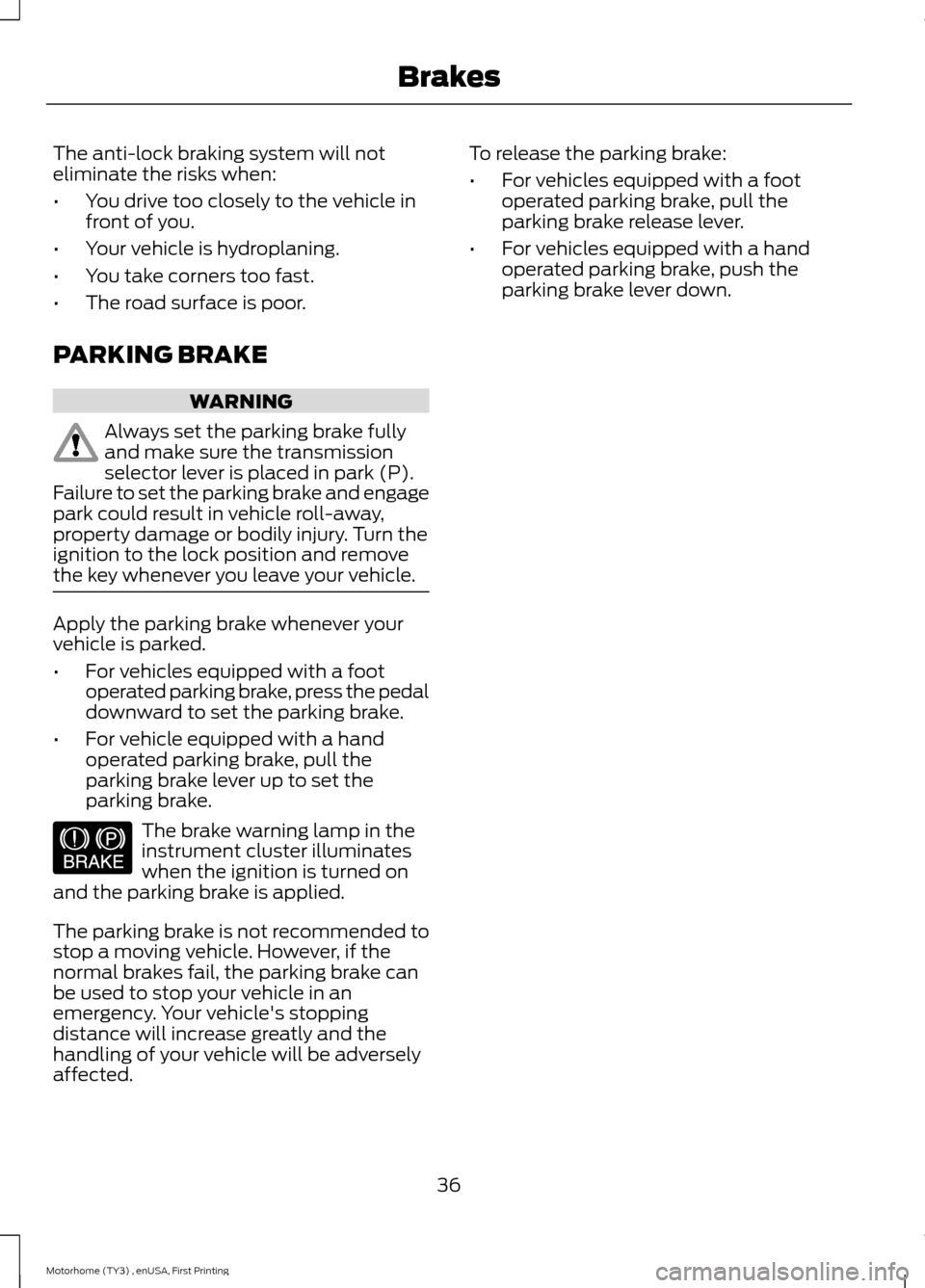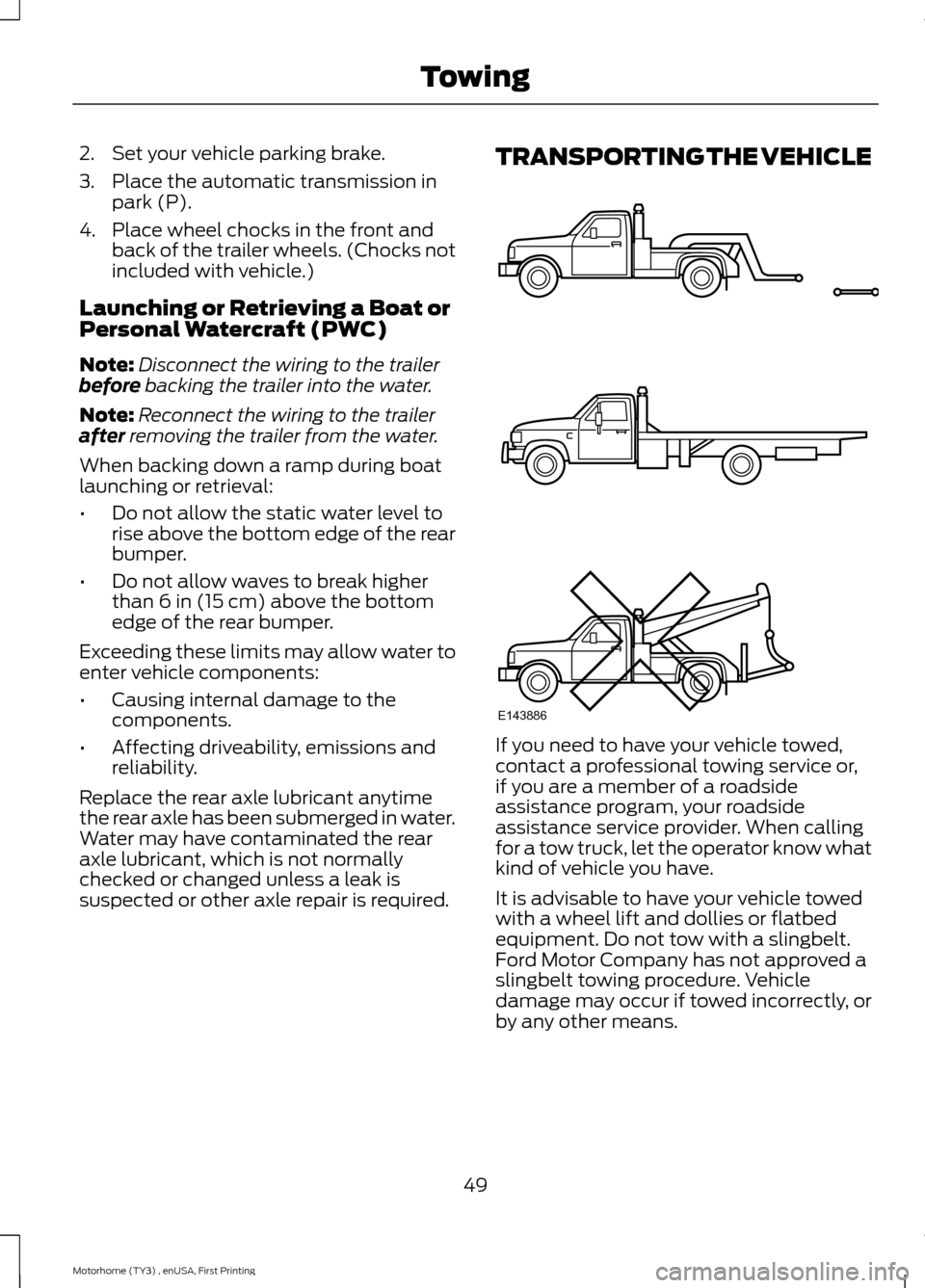Page 39 of 154

The anti-lock braking system will noteliminate the risks when:
•You drive too closely to the vehicle infront of you.
•Your vehicle is hydroplaning.
•You take corners too fast.
•The road surface is poor.
PARKING BRAKE
WARNING
Always set the parking brake fullyand make sure the transmissionselector lever is placed in park (P).Failure to set the parking brake and engagepark could result in vehicle roll-away,property damage or bodily injury. Turn theignition to the lock position and removethe key whenever you leave your vehicle.
Apply the parking brake whenever yourvehicle is parked.
•For vehicles equipped with a footoperated parking brake, press the pedaldownward to set the parking brake.
•For vehicle equipped with a handoperated parking brake, pull theparking brake lever up to set theparking brake.
The brake warning lamp in theinstrument cluster illuminateswhen the ignition is turned onand the parking brake is applied.
The parking brake is not recommended tostop a moving vehicle. However, if thenormal brakes fail, the parking brake canbe used to stop your vehicle in anemergency. Your vehicle's stoppingdistance will increase greatly and thehandling of your vehicle will be adverselyaffected.
To release the parking brake:
•For vehicles equipped with a footoperated parking brake, pull theparking brake release lever.
•For vehicles equipped with a handoperated parking brake, push theparking brake lever down.
36Motorhome (TY3) , enUSA, First PrintingBrakesE144522
Page 51 of 154

Trailer Brakes
WARNING
Do not connect a trailer's hydraulicbrake system directly to yourvehicle's brake system. Your vehiclemay not have enough braking power andyour chances of having a collision greatlyincrease.
Electric brakes and manual, automatic orsurge-type trailer brakes are safe if youinstall them properly and adjust them tothe manufacturer's specifications. Thetrailer brakes must meet local and federalregulations.
The rating for the tow vehicle's brakingsystem operation is at the gross vehicleweight rating, not the gross combinedweight rating.
Separate functioning brake systemsare required for safe control of towedvehicles and trailers weighing morethan 1500 pounds (680 kilograms)when loaded.
Trailer Lamps
WARNING
Never connect any trailer lamp wiringto the vehicle's tail lamp wiring; thismay damage the electrical systemresulting in fire. Contact your authorizeddealer as soon as possible for assistancein proper trailer tow wiring installation.Additional electrical equipment may berequired.
Trailer lamps are required on most towedvehicles. Make sure all running lights, brakelights, direction indicators and hazard lightsare working.
Before Towing a Trailer
Practice turning, stopping and backing upto get the feel of your vehicle-trailercombination before starting on a trip.When turning, make wider turns so thetrailer wheels clear curbs and otherobstacles.
When Towing a Trailer
•Do not drive faster than 70 mph(113 km/h) during the first 500 mi(800 km).
•Do not make full-throttle starts.
•Check your hitch, electrical connectionsand trailer wheel lug nuts thoroughlyafter you have traveled 50 mi (80 km).
•When stopped in congested or heavytraffic during hot weather, place thegearshift in park (P) to aid engine andtransmission cooling and to help airconditioning performance.
•Switch off the speed control withheavy loads or in hilly terrain. Thespeed control may turn offautomatically when you are towing onlong, steep grades.
•Shift to a lower gear when driving downa long or steep hill. Do not apply thebrakes continuously, as they mayoverheat and become less effective.
•If your transmission is equipped with aGrade Assist or Tow/Haul feature, usethis feature when towing. This providesengine braking and helps eliminateexcessive transmission shifting foroptimum fuel economy andtransmission cooling.
•Allow more distance for stopping witha trailer attached. Anticipate stops andbrake gradually.
•Avoid parking on a grade. However, ifyou must park on a grade:
1.Turn the steering wheel to point yourvehicle tires away from traffic flow.
48Motorhome (TY3) , enUSA, First PrintingTowing
Page 52 of 154

2.Set your vehicle parking brake.
3.Place the automatic transmission inpark (P).
4.Place wheel chocks in the front andback of the trailer wheels. (Chocks notincluded with vehicle.)
Launching or Retrieving a Boat orPersonal Watercraft (PWC)
Note:Disconnect the wiring to the trailerbefore backing the trailer into the water.
Note:Reconnect the wiring to the trailerafter removing the trailer from the water.
When backing down a ramp during boatlaunching or retrieval:
•Do not allow the static water level torise above the bottom edge of the rearbumper.
•Do not allow waves to break higherthan 6 in (15 cm) above the bottomedge of the rear bumper.
Exceeding these limits may allow water toenter vehicle components:
•Causing internal damage to thecomponents.
•Affecting driveability, emissions andreliability.
Replace the rear axle lubricant anytimethe rear axle has been submerged in water.Water may have contaminated the rearaxle lubricant, which is not normallychecked or changed unless a leak issuspected or other axle repair is required.
TRANSPORTING THE VEHICLE
If you need to have your vehicle towed,contact a professional towing service or,if you are a member of a roadsideassistance program, your roadsideassistance service provider. When callingfor a tow truck, let the operator know whatkind of vehicle you have.
It is advisable to have your vehicle towedwith a wheel lift and dollies or flatbedequipment. Do not tow with a slingbelt.Ford Motor Company has not approved aslingbelt towing procedure. Vehicledamage may occur if towed incorrectly, orby any other means.
49Motorhome (TY3) , enUSA, First PrintingTowingE143886
Page 72 of 154
Protected componentsFuse amp ratingFuse or relay number
Not used.—J18
Not used.—J19
Not used.—J20
Not used.—J21
Reverse lamp relay coil.20A**J22A/C clutch relay coil.A/C demand switch.
Horn relay.—R1
Fuel pump relay.—R2
Starter relay.—R3
Backup lamps relay.—R4
Brake on/off relay.—R5
Trailer tow parking lamps relay.—R6
Not used.—R7
Air conditioning clutch relay.—R8
Not used.—R9
Starter relay.—R10
Blower motor relay.—R11
Daytime running lamp/headlamp relay.—R12
Powertrain control module relay.—R13
Fuel pump diode.—D1
Air conditioning clutch diode.—D2
Not used.—D3
Not used.—C1
*Mini fuses.**J-case fuse.
69Motorhome (TY3) , enUSA, First PrintingFuses
Page 73 of 154
UPS Power Distribution Box 1
Protected componentsFuse amp ratingFuse or relay number
Powertrain control module.RelayR1
Daytime running lamps.RelayR2
Starter motor.RelayR3
Blower motor.RelayR4
Horn.RelayR5
Fuel pump.RelayR6
Starter ground.RelayR7
Trailer tow parking lamps.RelayR8
Backup lamps.RelayR9
Hydromax brake on/off relay.RelayR10
Not used.RelayR11
Air conditioning clutch.RelayR12
Hydromax brake on/off relay.10AM1-1
Turn/hazard brake lighting.20AM1-2
Not used.—M1-3
Not used.—M1-4
70Motorhome (TY3) , enUSA, First PrintingFusesE172543
Page 74 of 154
UPS Power Distribution Box 2
Protected componentsFuse amp ratingFuse or relay number
Backup lamps.25A*M1
Daytime running lamps.20A*M2
4–channel anti-lock brake system module(Hydromax).30A*M3
Powertrain control module run/start.20A*M4Fuel pump relay coil.
Starter relay coil.10A*M5
Vehicle power 4.20A*M6Ignition coils.
Hydromax motor monitor.5A*M7
Vehicle power 2.20A*M8
Vehicle power 1.20A*M9Mass air flow sensor.
Air conditioning.10A*M10
Powertrain control module relay keep alivepower.5A*M11
Canister vent valve.
Parking lamps feed.20A*M12Trailer tow running lamp relay coil.
One-touch start.DiodeD1
71Motorhome (TY3) , enUSA, First PrintingFusesE172544
Page 75 of 154
Protected componentsFuse amp ratingFuse or relay number
Fuel pump.DiodeD2
Air conditioning.DiodeD3
Not used.—R2-1
Powertrain control module vehicle power.30A**J1
Fuel pump.20A**J2
Cigar lighter power point.20A**J3Diagnostic connector.
Blower motor.40A**J4
Headlamps.30A**J5Daytime running lamps on/off relay coil.Headlamp daytime running lamp relayfeed.
Ignition switch feeds (instrument panelfuses #F26).40A**J6
Ignition switch feeds (instrument panel#F21, F26).40A**J7
Instrument panel fuse box F11, F13, F15.50A**J8
Starter relay feed.30A**J9
4–channel anti-lock brake system module(Hydromax).60A**J10
Trailer tow electronic brake.30A**J11
Lighting (instrument panel fuses #F3, F5;power distribution box M1-2).60A**J12
Vehicle power 3.20A**J13
Horn.20A**J14
4–channel anti-lock brake system module.60A**J15
Trailer tow parking lamps.20A**J16
*Mini fuse.**J-case fuse.
72Motorhome (TY3) , enUSA, First PrintingFuses
Page 76 of 154
Diode and Relay ModuleLocate the module box with the powerdistribution box in from of the radiator.
Protected componentsRelay location
Not used.1
Not used.2
Not used.3
Daytime running lamps power relay.4
Hydromax – brake on/off signal isolating relay.5
Reverse lamps relay.6
Starter ground relay.7
Trailer tow parking lamps relay.8
Fuse Holder Module
Locate the fuse holder next to the diodeand relay module.
Protected componentsFuse amp ratingFuse number
Hydromax – brake on/off signal.10A1
73Motorhome (TY3) , enUSA, First PrintingFusesE161520